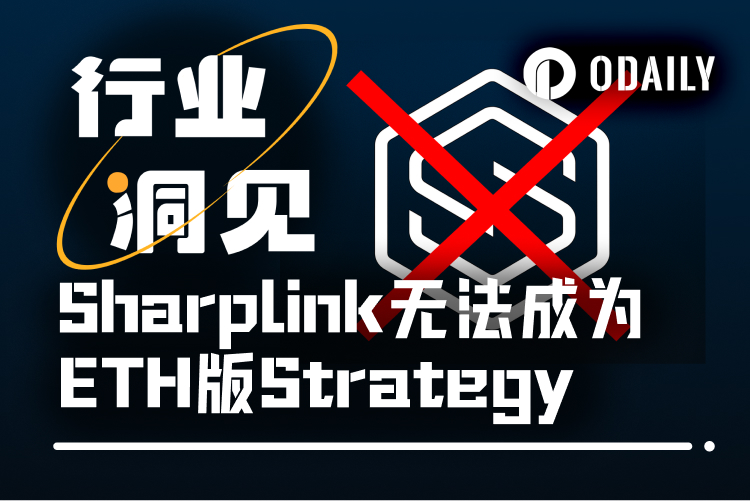Has the Sharplink narrative bubble burst? ETH version Strategy still undecided
Original | Odaily Planet Daily (@OdailyChina)
Author|Golem (@web3_golem)

On July 17, SharpLink Gaming (SBET) announced in an updated prospectus submitted to the U.S. SEC that it plans to issue an additional $5 billion in common stock on top of the originally planned $1 billion to further purchase ETH. After the news was released, SBET's stock price rose to a high of $38.91 that day, but then began to decline. The closing price for the week of July 19 was $28.98, and at the opening on Monday, SBET's stock price fell again, closing at $25.25.
This is puzzling—following the Strategy playbook, SharpLink Gaming, as a leading "ETH version of Strategy," should see its stock price spiral upwards with every move that favors ETH accumulation, especially during ETH's continuous breakthroughs. Yet, "bizarrely," investors who added SBET last week were left holding the bag at the peak. Has the Strategy playbook stopped working?
Market opinions generally summarize two main reasons for SBET's decline:
First, last week, BitMine's ETH reserves (300,657) briefly surpassed SharpLink's, becoming the entity holding the most ETH, threatening SharpLink's title as the "ETH version of Strategy." However, on July 19, according to public information, SharpLink continued to accumulate ETH, with total holdings reaching 345,158, valued at over $1.2 billion, once again becoming the entity with the largest ETH reserves.
Second, SharpLink Gaming's combined financing method of Private Investment in Public Equity (PIPE) and At-The-Market (ATM) offerings for purchasing ETH has begun to face market skepticism. SharpLink's additional $5 billion equity quota is not a stimulant for price increases but rather a trigger for market panic.
SharpLink's Financing Method Raises Market Concerns
Before understanding what investors are worried about, we need to clarify SharpLink's combined financing method of PIPE and ATM. Strategy's purchase of BTC was funded through convertible bond financing, with risks including debt maturity pressure and interest payments, but it does not cause significant equity dilution or market selling pressure, making it a better strategy for "stepping on each other's feet to rise" during BTC's upward phase.
However, Private Investment in Public Equity (PIPE) directly dilutes equity and creates selling pressure on the stock price. At the end of May, SharpLink Gaming completed a $425 million PIPE, after which the stock price rose from a few dollars to $80. But on June 12, due to market rumors that "PIPE investors have started to apply for出货," SBET's stock price crashed over 70% in a single day, returning to single digits. Although SharpLink's board chairman and Consensys CEO Joseph Lubin later clarified that no PIPE investors had actually sold, it reflected that if selling were to occur, it would deal a fatal blow to SBET's price.
The $425 million financing alone does not support SharpLink's purchase of more ETH, so it also adopted the ATM method to raise funds. ATM refers to a financing method where a listed company sells shares directly to the secondary public market at current market prices. ATM is not completed at once but continues until the target is met. SharpLink's total $6 billion equity issuance may mostly be completed this way. According to the company's disclosed SEC filings and announcements, as of July 11, SharpLink has raised $608.1 million through ATM.

SharpLink's ATM market price issuance after PIPE
Understanding SharpLink's financing model makes it easy to comprehend market concerns. The combination of PIPE and ATM financing methods not only causes immediate equity dilution for SEBT but also brings continuous stock increment pressure. Although PIPE investors have not sold yet, they remain a thorn over retail investors' heads and may already be quietly selling low-priced SEBT shares, cleverly avoiding disclosure.
Secondly, ATM is essentially a company's legal arbitrage behavior, continuously bringing selling pressure to the market. Moreover, compared to SharpLink's current market cap of about $2.9 billion, the future $5 billion issuance quota seems to drain market liquidity. The market can't help but question whether SharpLink is genuinely interested in ETH's long-term value or just using it as a reusable narrative lever.
SharpLink's ideal script might be: leveraging the crypto treasury trend to hoard ETH and boost the stock price, then using ATM to directly extract investor funds from the market to accumulate more ETH, thereby strengthening the "ETH version of Strategy" narrative to push the stock price higher, and then selling shares at highs, repeating the cycle. Additionally, ETH is an interest-bearing asset. According to SharpLink's latest disclosure, as of July 8, its ETH staking income reached 322 (worth approximately $1.22 million). This means SharpLink not only cashes out stocks at high prices into ETH through this stepping-on-each-other's-feet method but also enjoys capital appreciation gains, leaving only the retail investors who chased SBET high by selling ETH "losing both the lady and the pawn."
BitMine, Bit Digital, and GameSquare) also face equity dilution risks.
However, there is one ETH reserve listed company in the market that did not use equity financing to raise funds but adopted a convertible bond financing revolving loan model, also known as "TraFi DeFi hybrid financing structure," which is BTCS. As of July 21, BTCS holds a total of 55,788 ETH, ranking 10th among listed companies.
BTCS's "TraFi DeFi hybrid financing structure" means that on one hand, the company raises funds through convertible bonds and ATM in traditional finance to purchase ETH; on the other hand, BTCS uses ETH as collateral to borrow stablecoins from DeFi protocols like Aave to purchase more ETH.
According to official documents, as of July 21, BTCS has raised $132 million through ATM (including pending $28.4 million ATM sales at $7.9 per share and $10 million convertible notes to be completed) and $17 million through convertible bonds, using Aave stablecoin loans of $40 million (loan-to-value ratio below 40%).
BTCS's current market cap is $144 million. Although it also uses ATM financing, the scale is not as massive as SharpLink's, causing less dilution pressure on shareholders. Additionally, BTCS does not stake all its ETH but further uses on-chain leverage to accumulate more ETH. If ETH continues to rise, it will create a larger profit flywheel.
Because ETH itself has interest-bearing attributes and a well-developed DeFi ecosystem, unlike BTC reserve companies that can only hold BTC as digital gold in custody wallets, ETH reserve companies can use more financial tools to repeatedly cash out ETH.
But this also makes investors worry. Behind the complex financial tools, if all profits are based on ETH's rise, which financing model will collapse first if ETH weakens again?
The ETH version of Strategy has yet to be decided. SharpLink's stepping-on-each-other's-feet model is not based on ETH's continuous rise but on investors' trust. When investors realize that SharpLink's continuous arbitrage of stock reserves for ETH is not about believing in ETH's long-term value but merely a means to achieve balance sheet growth (the interest from staking ETH does not benefit shareholders), SharpLink's narrative will collapse.
BTCS's "TraFi DeFi hybrid financing structure" controls equity dilution but actively introduces on-chain lending, which carries greater risks. If ETH's upward momentum weakens and starts to decline, BTCS will have to face risks such as reduction or liquidation, which will negatively impact the stock price.
As investors gradually become clear and realize that reserving ETH is not as simple as directly buying BTC and storing it in a wallet, the market will no longer measure the value of an ETH reserve listed company solely by the "ETH reserve量" standard. But in any case, the current ETH reserve craze has indeed brought real buying and capital炒作噱头 to ETH. Therefore, instead of跨界炒加密美股, directly buying or going long on ETH is what our "noble加密 investors" should do.
